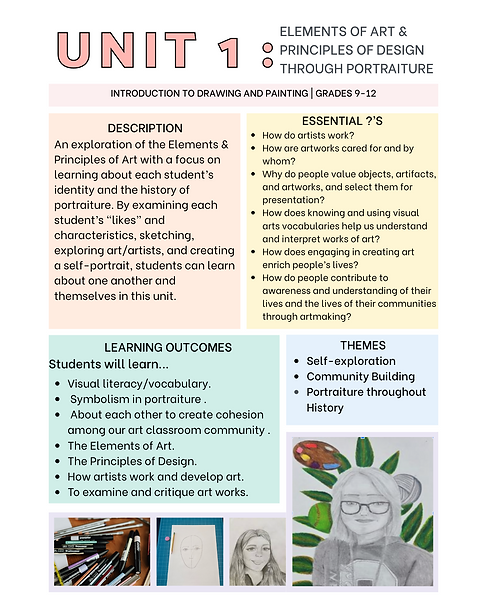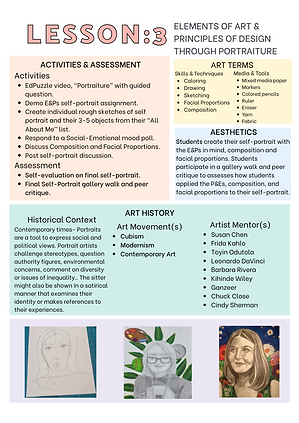

What is ART?
The expression of humans through various mediums, where we can reference the past, experience the present, and look to the future. Art can tell us about social norms, cultural practices, and an individual's experience or perception of the imagined or literal world. Art is enduring!
Philosophy of Art Education
It is incredibly gratifying to watch an individual learn about art. I want to expand my students’ knowledge, teach them a skill, enable them to construct art, and bolster their self-esteem. As a citizen of the world and a life-long learner because of my passion for art; I hope to teach these skills to my students, as these attributes make one a tolerant person, an informed individual, and inclined to critically question the world. Teaching art is exciting; I get to teach generations of students how to create art and to express what inspires or worries them. I have the privilege of seeing a glimpse of the world they come from through their art, and our conversations. The themes included throughout the year range from arts integration, community art projects, multicultural arts education, women in art, and exploring life skills through art projects.
My future students are taught the subject matter, I inform them about the community they live in and beyond, how to interact with one another with respect, and what is expected of them. Students feel supported, safe, and heard. Cultivating a sense of enjoyment for art, life and being ancillary in finding their artistic voices is vital. They must learn art terms, processes, positive peer interactions, and balancing home and school life to meet deadlines. Specifically, they learn about visual literacy which incorporates art vocabulary and the symbolism incorporated in the subject matter of art works. They learn to analyze subject matter, form, structure, proportions, perspective, and different uses of media or color to glean the mood or ideas artists display in their works. Students are exposed to art criticism to promote critical thinking, and to make them knowledgeable critics. Students learn different digital media approaches as well as a range of creative art forms. The approach to teaching my themes has tones of enthusiasm and expert knowledge. If they want to learn a new medium I may not be comfortable with, I read everything I can on the subject and master it before I expect them to do it. Incorporating the element of surprise in a lesson is a memorable learning moment. I have been known to dress up like Freida Kahlo in the past to make a lesson interactive for my students as they can ask me questions with me playing the artist.
Implementing my personal values and views as an art educator is challenging, but fruitful for my students. I must learn my students’ names and about their immediate families. Their first assignment is a self-portrait. This assignment showcases an art history timeline, and I can see each student’s skill level as they work. To ease the minds of any anxious students I share some of my artistic failures as needed. As students produce art, I check in with them one-on-one to talk about their processes, gain insight on their skill levels, and make sure they work within the rubric. Throughout the school year I focus on arts integration. Partnering with teachers in other departments, such as history, studying relevant historical events, and assigning students to produce a composition of an historical event that occurred in their lifetime or a favorite of theirs. Promoting a sense of community among my students is key to learning tolerance. A section in my classroom where students can find out about community art projects, such as murals, spoken word performances, plays, exhibitions, or art contests outside of school helps students who may not want to socialize in the classroom because the school setting is inhibiting for them. To promote becoming a citizen of the world I shed light on different cultures within our school’s demographics and prepare lessons to learn about various cultures through their customs and celebrations. I devote time to Women’s History Month in March by highlighting women artists. Women artists have been marginalized throughout history and I want to uplift women in class. Students choose a woman artist to learn about and make an art piece to pay them homage. When assessing the effectiveness of their work, I look at the time that was spent on the artwork, the resources they used, if they applied what we have learned, originality, and if the assignment was handed in on time.
While I know my ideals, goals, and the way I implement my vision may not be well received by all my students, I am encouraged to work to the best of my ability to support, teach, and nurture students. I also know that I can count on my background as a Spanish speaker, my knowledge of art, the knowledge I’ve gained on my travels, the experience of being the daughter of immigrants, having a mixed-race family, and my tenacity to not give up on my students or myself. Overall, I hope my future art classroom is a safe space for relevant learning experiences, where I model culturally competent strategies for my students, and minimize my bias by being self-aware.







.png)
